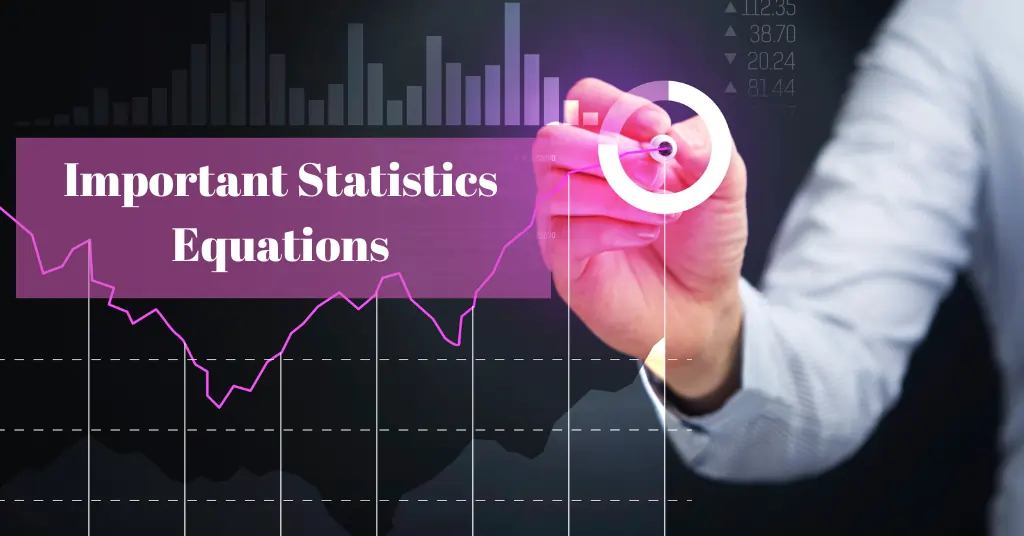Karl Pearson has beautifully said – “Statistics Is The Grammar Of Science”
Although statistics is said to be a part of mathematics. There are various application of mathematics in statistics.
The mathematics of working with numeric data and analyzing it is called statistics. More formally, it is the study of data collection, interpretation, organization, and presentation. According to statistical theory, a statistic is a function of a sample that doesn’t depend on the sample’s distribution. Statistics equations enable you to measure the tendencies of a population in various ways and work out the deviation of values.
This branch of math enables you to draw insights from data and even predict patterns and possibilities by working with the facts of the numeric data. Here is a collection of important statistics math equations that students, statisticians, marketing analysts, financial analysts, and a wide array of professionals commonly use.
Statistics Probability Equations
Table of Contents
Here are seven common statistics equations:
#1 Population Mean
This term refers to the average of a characteristic in a population. The formula is:
μ = ( Σ Xi ) / N
Here, “μ” is the population mean, “Σ Xi” refers to the sum of the characteristics in the population, and “N” is the total size of the population.
#2 Population Standard Deviation
Standard deviation is a measure of the “spread” or the variability of scores in a data set, represented by:
σ = sqrt [ Σ ( Xi – μ )2 / N ]
As you may have figured out, the term is represented by “σ.” “Sqrt” denotes the square root, and Σ ( Xi – μ )2 is the sum of the squared deviations of the values minus the population mean.
#3 Population Variance
The variance shows us the spread of the values in a population and is the square of the standard deviation. The formula is:
σ2 = Σ ( Xi – μ )2 / N
#4 Sample Mean
The average score of a sample on a specific variable is its sample mean, and its formula is:
x_bar = ( Σ xi ) / n
It is the sum of the scores in the sample divided by the total number of data points in the sample.
#5 Sample Standard Deviation
The term represents the spread of the scores in a sample for a specific variable. Here’s its formula:
s = sqrt [ Σ ( xi – x_bar )2 / ( n – 1 ) ]
In this formula, the “Σ ( xi – x_bar )2” represents the sum of squared deviations of scores from the sample mean.
#6 Sample Variance
It is the square of the sample standard deviation and is denoted by s2, like so:
s2 = Σ ( xi – x_bar )2 / ( n – 1 )
Probability Statistics Equations
The probability of something represents the possibility of an outcome of an event. It is a test of the likelihood of something happening. The most common way of explaining this is the coin toss – the possibility of the coin showing heads or tails is half and half.
The formula for the probability of an event E is:
P(E) = Number of positive outcomes/Number of total outcomes = n(E)/n(S)
There are many statistics equations that are used by students and professionals alike. If A and B are two events, then:
| Bayes Formula | P(A|B) = P(B|A) P(A)/P(B) |
| Conditional Probability | P(A|B) = P(A∩B)/P(B) |
| Disjoint Events | P(A∩B) = 0 |
| Independent Events | P(A∩B) = P(A)P(B) |
| Mutually Exclusive Events | P(A∪B) = P(A) + P(B) |
| Probability Range | The likelihood of an event ranges from 0 to 1. This is expressed mathematically as 0 ≤ P(A) ≤ 1. |
| Rule of Addition | P(A∪B) = P(A) + P(B) – P(A∩B) |
| Rule of Complementary Events | P(A’) + P(A) = 1 |
Regression Equations Statistics
Regression equations allow us to determine whether there is any relationship between two data sets. The equations facilitate regression analysis, one of the most popular methods to determine the connection between dependent and independent variables.
The equations help assess the strength of the connection between two variables and depending on the outcome; the equations may be used to model the relationship between the variables later.
A simple regression analysis is measuring the height growth of a child. Let’s say you measure the child’s height annually and determine that they grow three inches every year. This trend of growth may be modeled using a regression equation.
Real-world regression analysis examples include calculating the odds of natural disasters and price changes in commodities of all kinds.
The formula for regression is:
Y = a + bX + ∈
The “Y” is the dependent variable, and as you can guess, “X” is the independent variable. The “a” represents the intercept, “b” is the slope, and “∈” is the error.
Working out the values of the intercept and slope is as simple as applying the following formula:
a = (Σy)(Σx2) – (Σx)(Σxy)/ n(Σx2) – (Σx)2
b = n (Σxy) – (Σx)(Σy) /n(Σx2) – (Σx)2
Conclusion
Statistics is considered to be a game changer, and statistical techniques are created to examine the key factors of vast data. Various organisations and governments utilise statistical methods to compute a collective characteristic about workers or people. This property then influences the decisions that the organisations and governments make.
Today, we have discussed all the important statistics equations that are useful to improve your statistics knowledge. Try to remember these equations as, without these, you can not solve any of the statistics-related problems.


